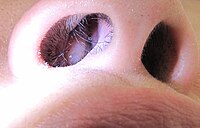
Photo from wikipedia
Pneumoconiosis staging has been a very challenging task, both for certified radiologists and computer-aided detection algorithms. Although deep learning has shown proven advantages in the detection of pneumoconiosis, it remains… Click to show full abstract
Pneumoconiosis staging has been a very challenging task, both for certified radiologists and computer-aided detection algorithms. Although deep learning has shown proven advantages in the detection of pneumoconiosis, it remains challenging in pneumoconiosis staging due to the stage ambiguity of pneumoconiosis and noisy samples caused by misdiagnosis when they are used in training deep learning models. In this article, we propose a fully deep learning pneumoconiosis staging paradigm that comprises a segmentation procedure and a staging procedure. The segmentation procedure extracts lung fields in chest radiographs through an Asymmetric Encoder-Decoder Network (AED-Net) that can mitigate the domain shift between multiple datasets. The staging procedure classifies the lung fields into four stages through our proposed deep log-normal label distribution learning and focal staging loss. The two cascaded procedures can effectively solve the problem of model overfitting caused by stage ambiguity and noisy labels of pneumoconiosis. Besides, we collect a clinical chest radiograph dataset of pneumoconiosis from the certified radiologist's diagnostic reports. The experimental results on this novel pneumoconiosis dataset confirm that the proposed deep pneumoconiosis staging paradigm achieves an Accuracy of 90.4%, a Precision of 84.8%, a Sensitivity of 78.4%, a Specificity of 95.6%, an F1-score of 80.9% and an Area Under the Curve (AUC) of 96%. In particular, we achieve 68.4% Precision, 76.5% Sensitivity, 95% Specificity, 72.2% F1-score and 89% AUC on the early pneumoconiosis ‘stage-1’.
Journal Title: IEEE Journal of Biomedical and Health Informatics
Year Published: 2022
Link to full text (if available)
Share on Social Media: Sign Up to like & get
recommendations!